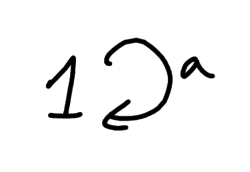Difference between revisions of "M(16,1,1)"
(Created page with "{{blockbox |title = M(16,1,1) - <math>kC_{16}</math> |image = M(2,1,1)quiver.png |representative = <math>kC_{16}</math> |defect = <math>C_{16}</math> |inertialquotie...") |
(Pic_k) |
||
| Line 8: | Line 8: | ||
|l(B) = 1 | |l(B) = 1 | ||
|k-morita-frob = 1 | |k-morita-frob = 1 | ||
| − | |Pic-k= | + | |Pic-k = <math>k^{14}:k^*</math> |
|cartan = <math>\left( \begin{array}{c} | |cartan = <math>\left( \begin{array}{c} | ||
16 \\ | 16 \\ | ||
Latest revision as of 14:22, 7 October 2018
M(16,1,1) - [math]kC_{16}[/math]
| Representative: | [math]kC_{16}[/math] |
|---|---|
| Defect groups: | [math]C_{16}[/math] |
| Inertial quotients: | [math]1[/math] |
| [math]k(B)=[/math] | 16 |
| [math]l(B)=[/math] | 1 |
| [math]{\rm mf}_k(B)=[/math] | 1 |
| [math]{\rm Pic}_k(B)=[/math] | [math]k^{14}:k^*[/math] |
| Cartan matrix: | [math]\left( \begin{array}{c} 16 \\ \end{array} \right)[/math] |
| Defect group Morita invariant? | Yes |
| Inertial quotient Morita invariant? | Yes |
| [math]\mathcal{O}[/math]-Morita classes known? | Yes |
| [math]\mathcal{O}[/math]-Morita classes: | [math]\mathcal{O} C_{16}[/math] |
| Decomposition matrices: | [math]\left( \begin{array}{c} 1 \\ 1 \\ \vdots \\ 1 \\ \end{array}\right)[/math] |
| [math]{\rm mf}_\mathcal{O}(B)=[/math] | 1 |
| [math]{\rm Pic}_{\mathcal{O}}(B)=[/math] | [math]\mathcal{L}(B)=C_{16}:(C_4 \times C_2)[/math] |
| [math]PI(B)=[/math] | {{{PIgroup}}} |
| Source algebras known? | Yes |
| Source algebra reps: | [math]kC_{16}[/math] |
| [math]k[/math]-derived equiv. classes known? | Yes |
| [math]k[/math]-derived equivalent to: | Forms a derived equivalence class |
| [math]\mathcal{O}[/math]-derived equiv. classes known? | Yes |
| [math]p'[/math]-index covering blocks: | M(16,1,1) |
| [math]p'[/math]-index covered blocks: | M(16,1,1) |
| Index [math]p[/math] covering blocks: | {{{pcoveringblocks}}} |
These are nilpotent blocks.
Contents
Basic algebra
Quiver: a:<1,1>
Relations w.r.t. [math]k[/math]: [math]a^{16}=0[/math]
Other notatable representatives
Projective indecomposable modules
Labelling the unique simple [math]B[/math]-module by [math]S_1[/math], the unique projective indecomposable module has Loewy structure as follows:
[math]\begin{array}{c} S_1 \\ S_1 \\ \vdots \\ S_1 \\ \end{array} [/math]
Irreducible characters
All irreducible characters have height zero.
